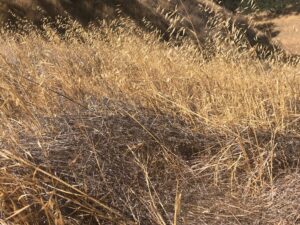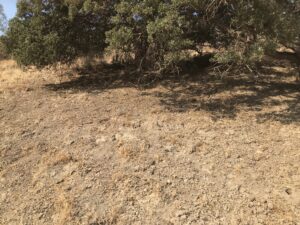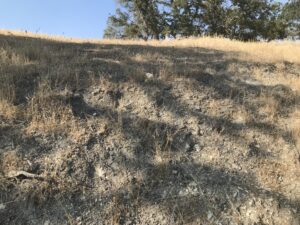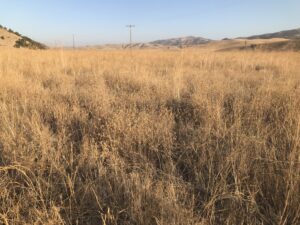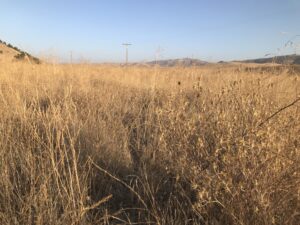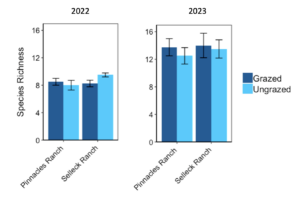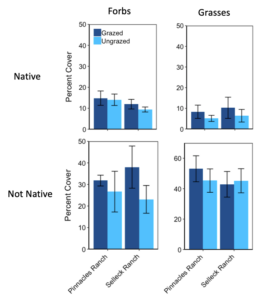Final report for FW20-364
Project Information
Willow Creek Land and Cattle, LLC, a new business established by a young brother and sister entrepreneur team in 2018, proposes to test and evaluate the efficacy of adaptively managed, targeted, rotational cattle grazing as an ecosystem management tool for California's Mediterranean grasslands and as an economically viable business model for cattle production. During a 3-year study period, Willow Creek Land and Cattle, LLC will conduct rigorous ecosystem surveys, a series of exclosure-grazing treatment experiments, and multi-variable evaluations of livestock performance and economic costs and returns on two California coastal ranches. This project is particularly relevant and timely as California’s Mediterranean grasslands have declined dramatically over the last few centuries due to introductions of nonnative species, agricultural intensification, and urban expansion. Grassland degradation coupled with increasingly extreme drought and fire regimes threaten the economic viability of farmers and ranchers, who rely on productive and resilient grassland ecosystems for livestock production. The data generated during the 3-year study period will help inform other producers in California interested in ecosystem restoration as an additional source of income for cattle operations, as well as directly support the goals of a small, new business founded by two young ranchers. The economic viability and social prosperity of livestock producers depends on managing livestock grazing with the goal of enhancing grassland plant communities while simultaneously promoting livestock performance. This project will improve our understanding of grazing as a tool for management and restoration of grasslands and test whether these management approaches are economically viable and competitive.
This project will investigate the ecological and economic outcomes of employing targeted grazing practices on two cattle ranches on California’s central coast. Specifically our goals are:
- Measure the effect of specific grazing treatments with cattle on:
- Species richness, density, and cover of native perennial grasses
- Species richness and cover of native forbs
- Species richness and cover of Cal-IPC listed invasive plants
- Recruitment, growth, and survival of Blue oak (Quercus douglasii) seedlings
- Determine whether cattle performance is improved, reduced, or unaffected when cattle are utilized for targeted grazing projects.
- Evaluate the economic efficacy of targeted grazing as both a business model and as a grassland management tool by conducting a cost and return case study comparing rotational grazing with cattle to:
- Common alternative land management approaches such as herbicide application and mechanical treatment
- Results of previous cost-profit analyses conducted on California Central Coast ranches
- Disseminate results to farmers, ranchers, and land managers through demonstration events, blog posts, articles in professional journals, and presentations at conferences.
Cooperators
- - Technical Advisor
- - Producer
- - Producer
Research
We implemented a 3-year program of targeted, rotational cattle grazing on two California ranches (Pinnacles Ranch and the Selleck-Ivens Ranch) and assessed the ecological and economic outcomes of that management approach.
Study Location
Pinnacles Ranch (Paicines, CA, 200 acres) and the Selleck-Ivens Ranch (King City, CA, 630 acres) are located about 20 miles apart on California's Central Coast. The ranches have variable soils, topography, plant communities, and management histories. When the project started in 2018, both ranches showed evidence of ecological degradation and decreased rangeland productivity (Figures 1-3)
Figure 1. Pinnacles Ranch, September 2018: Dominance of thatch dependent invasive annual grasses, slender oat (Avena Barbata) (left) and red brome (Bromus madritensis ssp. rubens) (right).
Figure 2. Selleck-Ivens Ranch, October 2019: Low forage production, topsoil loss and erosion on the ranch's mountainous areas.
Figure 3. Selleck-Ivens Ranch, October 2019: Dense cover of invasive plants, yellow star thistle (Centaurea solstitialis) and black mustard (Brassica nigra) in previously farmed lowlands.
Grazing Treatment
Throughout the study period, both ranches were managed by Willow Creek Land and Cattle, LLC (WCLC) using a targeted, rotational grazing program in which paddock size generally ranged from 10-40 acres and cattle were moved every 1-2 weeks, depending on paddock size and forage availability. The exact timing and duration of grazing each year was variable depending on rainfall and forage availability. However, each ranch received one growing season (December-May) graze and one dormant season (June-November) graze per year. The one to this exception was 2022, during which extreme drought necessitated reducing the amount of grazing on each ranch. Within each ranch, grazing paddocks were ordered in an attempt to target invasive species during critical points of the life cycle, such as bolting and flowering while avoiding severe defoliation of native grasses and forbs at highly sensitive points of the life cycle. During the growing season, WCLC moved cattle to a new paddock if over 75% of available forage showed evidence of herbivory or trampling or if the cattle had created a visible increase in bare ground relative to pre-graze conditions. During the dormant season, WCLC used residual dry matter (RDM) to determine when to move cattle. Cattle were moved once visual assessment indicated that RDM was less than 2,000 lb/acre.
From the onset of this study in 2020 through the end of 2021, WCLC grazed 32 Angus heifers on the Selleck-Ivens Ranch and Pinnacles Ranch. In 2022, WCLC switched from stocker/heifer operation to a cow-calf operation and in 2022 and 2023 WCLC grazed 20 Angus cow-calf pairs on the two ranches.
Throughout the study period, we collected the following data on the grazing treatments: 1) area of each targeted grazing paddock; 2) grazing start date for the paddock; 3) number of days the paddock was grazed; 4) number of animal units (AU) utilizing the paddock (1 AU = 1,000 lb of livestock); 5) stocking rate (CDA; see Equation 1); and 6) number of days of recovery since the last graze. In addition, we regularly collected weather (e.g., rainfall timing and amounts) and other observational data using photo-documentation and field notes.
Equation 1: Cattle days per acre (CDA) = (AU × Days)/Acres
Exclosure Experiment
We assessed the ecological outcomes of grazing over the three year study period using paired exclosure-treatment plots and a random stratified sampling design. To limit variation in plant community responses due to varying soil types, we used NRCS soil data to select two soil map units on the Selleck-Ivens Ranch (LnF2 and LnF3) and two soil map units on Pinnacles Ranch (LnE2 and PnG3), on each of which we placed two paired exclosure-treatment plots (Figure 4). In each soil map unit, plots were placed in locations with native bunchgrass presence to allow monitoring of changes in bunchgrass density and cover.
Figure 4. Selleck-Ivens Ranch soils (left) and Pinnacles Ranch soils (right)22
Paired exclosure-treatment plots consisted of a 256 square foot exclosure and a 256 square foot unfenced area located 4 ft from the exclosure that was freely accessible to cattle during grazing treatments. Within each exclosure and treatment plot, we placed three line-point-intercept (LPI) transects along which we recorded every plant species present at 1ft intervals. Transects were 12 ft long and were spaced 4 ft apart. Using the LPI transects, we annually estimated the percent cover of each species and of non-living cover categories such as thatch and bare ground. We will also record the density of bunchgrasses and woody species along each transect, if present.
We constructed all grazing exclosures throughout the fall of 2020 and began collecting data in the exclosure and treatment plots on each ranch in 2021.
Oak Woodland Monitoring
At Pinnacles Ranch, we randomly selected 12 adult blue oaks (DBH ≥ 12.7 cm) to use as survey points for oak woodland recruitment. In 2020 and 2022, we measured the DBH (diameter at breast height) of each selected adult oak and scoring the tree based on canopy dieback. In addition we recorded the density of juvenile oaks (DBH < 12.7 cm) by height class (less than 1 m, 1-2 m, and greater than 2 m) within 1.5 times the canopy radius of the selected adult oak.
Livestock Performance
Thoughout the study period, WCLC used several different metrics to track livestock performance. In 2020, when WCLC was grazing heifers, we weighed heifers at the begining and end of each grazing period on each property and calculated average daily weight gain per day. In 2021, WCLC began grazing cow-calf pairs, so we had to adjust our livestock performance metrics to be more relevant fa cow-calf operation. Specifically, we collected data on body condition score (BSC; https://extensionpublications.unl.edu/assets/pdf/ec281.pdf) and fertility of all cows. For any calves produced, we estimated birth weight and then weighed the calves at weaning and immediately prior to sale.
Cost and Return Case Study
We developed a case study examining the costs and returns of Willow Creek Land and Cattle, LLC’s targeted cattle grazing operation. Costs associated with targeted grazing were compared to those associated with alternative common alternative land management approaches such as herbicide application and mechanical treatment. In addition costs and returns for Willow Creek Land and Cattle, LLC were compared to two recently published cost and return studies from our region, one for a 300 head cow-calf operation on the Central Coast in 2018 (https://bit.ly/338NZ0A)23 and the other for a 100 head cow-calf operation on Public Lands in San Francisco Bay Area from 2017 (https://bit.ly/36mUajO)24. Targeted grazing operations have costs above and beyond those of a typical operation, such as monitoring specific natural resources of interest, moving animals at a critical time, or installing extra fencing or watering infrastructure in order to better target specific areas. Such additional costs had to be accounted for in our case study.
Grazing Treatment
To graze to our desired level of ground cover (see Methods and Analysis), we determined that CDAs had to be adjusted dramatically in response to both rainfall and topography. Table 1 below shows the average CDAs per ranch per year. CDAs were significantly lower during the drought in 2022 on both properties and were consistently lower on the Selleck-Ivens Ranch relative to Pinnacles Ranch. The Selleck-Ivens Ranch has similar per-acre forage production as Pinnacle Ranch, but is very steep and difficult for cattle to efficiently travel, which we believe accounts for the difference in CDAs between the two properties.
Table 1. Average CDAs per ranch throughout SARE study period
| Pinnacles Ranch | Selleck-Ivens Ranch | |
| 2020 | 15.8 | 8.9 |
| 2021 | 16.5 | 5.6 |
| 2022 | 8.7 | 2.8 |
| 2023 | 17.0 | 7.8 |
Exclosure Experiment
Targeted rotational grazing did not have any statically significant effects on plant cover or diversity. One possible explanation for this is that three years may not be a long enough study period for substantial differences in plant community composition to develop between grazed and ungrazed sites. By the third year of the study, some slight differences appeared to be developing between the grazed and ungrazed sites. These differences may become more pronounced over time.
1. Species diversity
Grazing produced only slight increases in species richness (defined as the number of species present) in each plot. The majority of the species richness on each ranch is comprised of native forbs, so any increase in species richness likely represents an increase in desirable, native forb cover. By the final year of the study (2023), average species richness per plot was slightly higher in grazed sites relative to ungrazed, but the difference was not statistically significant (Figure 5). In 2022, average species richness per plot was slightly higher grazed sites at Pinnacles Ranch but slightly lower in grazed sites at the Selleck Ranch. Given the extreme drought of 2022, it's possible that grazing negatively impacted some species. Conversely, in a relatively wet year like 2023, grazing may have helped to break the dominance of invasive annual grasses and improve growing conditions for native forbs.
2. Plant Cover
Native forbs and grasses had slightly higher cover in grazed plots in the final year of the study (Figure 6). Non-native forbs also had slightly higher cover in grazed plots, but this difference was mostly due to increased cover of filaree (Eroidum spp.) in grazed plots. Filaree is a naturalized forb in California that has excellent nutritional value for livestock, so the increased cover of this plant in grazed plots is not necessarily a negative finding despite this species being non-native. Non-native grasses had higher cover in grazed plots at Pinnacles Ranch but lower cover in grazed plots at the Selleck-Ivens Ranch in the final study year. Notable, the cover of two highly undesirable non-native grasses, ripgut brome (Bromus diandrus) and red brome (Bromus madritensis), was lower in grazed plots at both ranches while the cover of a higher forage value non-native grass, soft chess (Bromus hordeaceous) was higher in grazed plots. Collectively, these findings indicate that, although targeted rotational grazing did not produce overall decreases in non-native grass cover, it did produce benefits in forage quality on both ranches.
Oak Woodlands
Mature oak trees showed no significant change in size or canopy health throughout the study period. However, juvenile oak density was dramatically higher in 2022 than 2020. The average number of juvenile trees per mature tree was 2.8 in 2022 but was only 0.1 in 2020. Before this study, Pinnacles Ranch was not grazed for over 10 years and had substantial buildup of herbaceous biomass in the oak woodlands. We hypothesize that targeted grazing has helped prevent the over accumulation of herbaceous biomass and improved the conditions for oak seedling germination and survival.
During oak woodland surveys, we observed that nearly all juvenile oaks were very small (less than 1 ft tall), which lead us to consider whether herbivory from cattle and wildlife may be preventing the growth and survival of juvenile oaks. We resurveyed the oak woodlands and found that only 26% of the juvenile oaks showed any evidence of herbivory. We concluded that, while livestock herbivory may plan a minor role in oak growth and survival, the low rate of herbivory suggests that drought and competition with herbaceous plants may be more important factors.
Livestock performance
Targeted rotational grazing did not appear to have any positive or negative effects on livestock performance relative to industry standards. Cow BCS scores ranged from 2.5 to 4.0 throughout the study period, with the lowest scores tending to occur in the fall and the highest scores tending to occur in the spring. The average calving rate for the cow-calf herd was 80%. This is a low rate but we believe that it was due to an outbreak of Foothill Abortion Disease and not to the targeted rotational grazing program. The cow-calf herd had an average weaning rate of 97%. 7-month-old calves were weaned at an average of 660 lb. These herd statistics are all in-line with or above standard for typical cow-calf operations in this area, indicating that leveraging cattle for targeted rotational grazing has no detrimental impacts on livestock performance.
Economic analysis
The main economic benefit of targeted rotational grazing was reduced land rental rates. WCLC reported paying lease rates at approximately 30% below market rate, indicating a significant financial advantage to marketing a targeted rotational grazing approach to land management. The largest economic consequence of targeted rotational grazing is increased labor. Erecting portable electric fencing and portable water in order to support targeted rotational grazing is by far the most labor intensive element of WCLC.
Research outcomes
Findings from this project indicate that targeted rotational grazing can provide ecological benefits and may be a viable business model for livestock producers. Ecological and economic data from this project was difficult to analyze due to the short project duration, radically variable rainfall between each of the study years, and evolutions in the WCLC business (e.g., the transition from stockers to cow-calf). However, the emerging trends of slightly higher species diversity and native cover in grazed sites are encouraging and worthy of further study.
We feel that this research can be built on by further exploration of the mechanisms by which grazing can promote native plant cover and diversity. For example, significant past rangeland research in California has explored the connection between residual dry matter (RDM) and species diversity. Since we did not measure RDM, we would be interested to understand whether the moderation of RDM via dormant season grazing was important for promoting native plant cover and diversity. Further research could also explore the connection between targeted rotational grazing and forage quality. Proponents of rotational grazing often argue that frequent rotation of cattle prevents animals from over-using and "grazing out" the most palatable species. Since we found that highly palatable grasses and forbs tended to have greater cover in grazed sites, our research supports this theory. Using grazing management to improve forage quality could have profound economic benefits for ranchers.
Findings from this project indicated that, although targeted rotational grazing may have ecological and economic benefits, these benefits take time to emerge. This topic is well-worth further study to determine how best to implement targeted rotational grazing in manner that maximizes ecological benefits and but also controls management costs for the rancher.
Education and Outreach
Participation summary:
We conducted a robust education and outreach that consisted of four different outreach methods. We 1) hosted a field day, 2) gave PowerPoint presentations at five conferences, 3) wrote two articles (one in 2021 and one in 2022) for ranchers and the general public that were published on a blog and on BenitoLink (https://benitolink.com), and 4) are developing an article focused on project findings for a trade magazine or journal.
Outreach activities are not only educational, but can be fun. They are a great way for producers to engage with each other and share with their neighbors what has worked or not worked on their ranch. We hosted an outreach event in 2023 at the Selleck-Ivens Ranch. The event had over 30 attendees that included producers, agency personnel, and elected officials. This diversity of attendees led to valuable interactions and a rich exchange of ideas and land management philosophies. The event allowed for both peer to peer learning, but also learning among different groups. Attendees toured study sites on the Selleck-Ivens Ranch and watched a stockmanship demonstration. The ranch tour was followed by roundtable discussion of grazing management, conservation, and importance of working lands in conservation. One county elected official attended the event and interacted extensively with WCLC staff and other producer attendees.
In addition to the field day, PI Reikowski presented results from this project at the following five conferences:
- San Benito County Weed Management Area (December 2021; approx. 50 attendees)
- California Oak Symposium (October 2022; approx. 60 attendees)
- EcoFarm (January 2023; approx. 30 attendees)
- California Rangeland Conservation Coalition (February 2023; approx. 100 attendees)
- San Mateo County Weed Management Area (September 2023; approx. 20 attendees)
PI Reikowski has also shared project results with university students via two guest lectures:
- University of Nevada, Reno (November 2021, approx. 20 rangeland management students)
- University of California, Berkeley (November 2022, approx. 30 environmental science students)
Several types of written materials are being produced through this grant. Collaborator Devii Rao wrote two articles for her Livestock and Range Blog to share our project and findings with producers and the general public. The blog articles were also posted on BenitoLink, which is San Benito County’s primary source for news, in order to reach a broader audience within the local community. In addition, we are preparing a technical article focused on project findings for a trade magazine (either California Cattlemen's Association or California Rangeland Trust).

